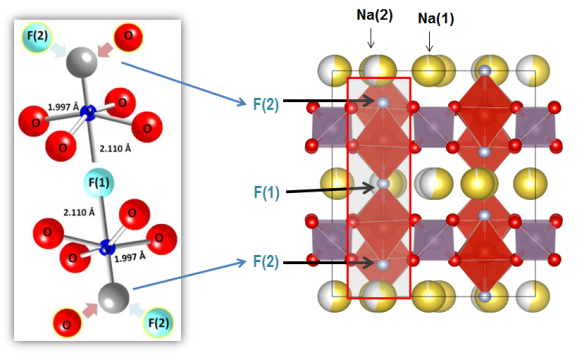A bit of a mouthful – sodium vanadium fluorophosphates: Na3V2O2x(PO4)2F3-2x
What does it look like?

Image generated by the VESTA (Visualisation for Electronic and STructural Analysis) software http://jp-minerals.org/vesta/en/
What is it?
Compounds in the Na3V2O2x(PO4)2F3-2x family have shown promise to be used in the next generation of batteries, as positive electrodes in rechargeable sodium-ion batteries. Yes, this is correct, researchers are feverishly trying to find out whether we can replace lithium-ion batteries with sodium-ion batteries. Why? The major reason is that sodium is much cheaper than lithium. However, a number of challenges in moving from lithium to sodium exist, one of the biggest of which is size – for a bigger charge carrier like sodium one needs a bigger tunnel, channel or hole. This is where the sodium vanadium fluorophosphates come into play. They have two sites which can host sodium and they have been shown to provide similar energy storage capabilities to lithium-ion battery positive electrodes in idealised systems. The challenges are to make a real system and test these materials for extended periods of time.
Although the sodium vanadium fluorophosphates may have a fancy application, these materials are actually synthetically and crystallographically fascinating! Synthetically because they are difficult to make and it is often the carbon content in the reagent mix that promotes formation with minimal impurities and some semblance of vanadium oxidation state control. Wait ... what? Carbon, there is no carbon in the formula? Well, carbon appears to influence the hydrothermal reaction to an extent and its role is still unclear. What is more interesting is the vanadium oxidation state and the ratio of F:O in the structure. F and O are very hard to differentiate using X-ray or neutron diffraction, a crystallographer's nightmare, but one can use bond length analysis, 23Na and 19F NMR, double titration, and XANES to figure out the ratio of F:O and then model this in diffraction data. Additionally, the ratio of F-:O2- tells us about the oxidation state of vanadium which is often mixed valent ranging from 3+ to 4+. To add further complexity to the situation there are four known polymorphs of this material and two of them can be present under ambient (room temperature and pressure) conditions. It is a challenging material to work with but if it can be used to realise sodium-ion batteries, the challenges are worth overcoming.
Where did the structure come from?
The original work on this system is likely to be the work of Le Meins et al. in 1999 (J.-M. Le Meins et al., J. Solid State Chem., 1999, 148, 260), but the work of Tsirlin et al. in 2011 (A.A. Tsirlin et al., Phys. Rev. B 2011, 84, 014429) and our work in Serras et al. in 2014 (DOI: 10.1039/c4ta00773e) address a number of pertinent issues that were concerning in the literature. We use in situ synchrotron X-ray diffraction to illustrate the structural evolution of this positive electrode in a sodium-ion cell.






